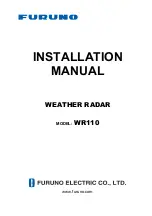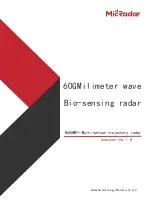
7
4) Survey antenna surroundings:
Ensure no interference to any surrounding antenna (e.g.: Broadcast, mobile (cell) phone station,
radio, BS/CS, etc.) and no obstacles should be around the antenna.
Moreover, secure a service space of 1 m or more around the antenna. In addition, strong reflections
can damage the receiver if there are obstacles nearby.
5) Power supply requirements:
Radar needs 100VAC (up to 240VAC), single phase 50/60Hz with GND. The minimum electric
current must be installed for voltage used, 100V is 10A, and 240V is 4.2A.
6) Telecommunication line and internet requirements:
Use telecommunication line for transferring weather observation data and operating the radar by
remote. The minimum require continuous speed to transfer all data in real time is 8 Mbps or faster. A
wireless network may have enough speed for just operating the system but we recommend you to
use a fast speed network like a fiber optic network when possible.
7) Building/ground structure:
The installed location of the radar must have proper load bearing resistance and durability to
support a tower or stand. However a structural plan from a professional architect and any required
permits may still be required for building or ground installation of the radar tower/mount.
8) Human health considerations:
Build the radar stand at least 2 meters high if the radar is installed where people have easy access
to radar. A sign board must also be placed at the entrance or ladder at radar access point.
9) Heating and cooling system:
Air conditioning is necessary to keep temperature stability for the room/cabinet (rack) of DPU.
10) Pseudo echo:
Set the sector blank to the obstacle direction nearby. When transmitting in the direction of the
obstacle, some pseudo echoes will be indicated due to reflections, therefore set the sector blank
until the pseudo echo disappear.
Caution:
1> DO NOT
looks at the antenna closer than noted below while radar is in operation. This energy can
be extremely damaging to the human body, especially the eyes. Furthermore
DO NOT
points the
antenna at any individuals closer than noted below while transmitting.
2>
As shown in Installation manual preface warnings (Table on page i, Radio Frequency Radiation
Hazard), the danger distance of transmit radio wave is set to 10W/m
2
value for safe standard,
therefore do not go closer than 7.6m to the radar.
1.7. Radar System Certificate
Most countries by law have specific certificates for operating radar as a radio station. The radar
frequency is in a shared radio spectrum with many other radio services, providing functions ranging
from air traffic control to amateur radio operations. Although the radio frequency spectrum is not a
physical resource, the use of a frequency at a given location usually precludes that same frequency
from being used by others in the same geographic area. This need to have exclusive geographic use to
prevent harmful interference has led to the current spectrum regulations and established spectrum use
rules. Such rules grant licenses for spectrum use, and partitioning of spectrum for shared use between
radio services.
These certifications are approved by the Ministry of Internal Affairs and Communications (Japan),
Federal Communications Commission (USA), or other agencies of the specific country. It is important to
apply when deciding the radar location because it will take time to get certification approval. It
sometimes takes up to a year.
Содержание WR110
Страница 1: ...INSTALLATION MANUAL WEATHER RADAR MODEL WR110 www furuno com...
Страница 49: ...43 6 OUTLINE DRAWING 1 Antenna Unit...
Страница 50: ...44 2 Junction Unit connection box...
Страница 51: ...45 3 Junction Unit Wall mounted type...
Страница 52: ...46 4 Data Processing Unit...
Страница 53: ...47 5 Data Processing Unit Power Supply...














































